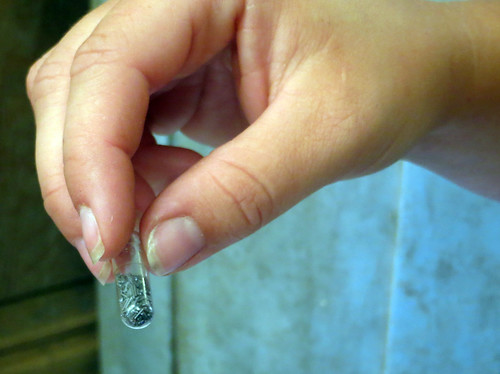On July 17, all of the bucks were given a gel cap containing 0.5 grams of copper oxide wire particles (COWPs). The copper rods in a 12.5 g bolus of Copasure®, a copper supplement for cattle, were repackaged into small doses for the goats. The gel caps were administered using a plastic balling gun.
The fecal samples collected on July 31 (d-56) were compared to the samples collected on July 17 (d-42) to determine the effectiveness of COWPs as an anthelmintic. The COWPs had an effect. Fecal egg counts (FECs) were significantly lower on July 31 as compared to July 17. There was also a slight improvement in FAMACHA© scores (+0.2).
On July 31 (d-56) , fecal egg counts ranged from 0 to 3600 epg and averaged 536 ± 733 epg. The median egg count was 288 epg. On July 17 (d-42), fecal egg counts ranged from 133 to 12800 and averaged 2727 ± 2526 epg. The median egg count was 2033 epg. The average fecal egg count reduction (FECR) was 46.1 percent.
On July 17, nine goats were dewormed with either moxidectin or levamisol. Deworming reduced their fecal egg counts by an average of 92.6 percent, 98.6 percent when the low data point was removed. When the treated goats were removed from the data set, the average reduction in fecal egg counts was 39.3 percent. However, the data was skewed because fecal egg counts increased in eight goats. When these goats were removed from the data set, fecal egg counts were reduced by 81.7 percent.
By way of comparison, the 15 bucks in the pasture group of the pen vs. pasture study were not given a COWP bolus. Their egg counts increased slightly, averaging 2317 ± 2224 epg on July 31.
It is not known why the COWPs were not effective in 8 goats. Perhaps, they spit the gel cap out when no one was looking. Nor is the mechanism of the copper wire particles fully understood. Do the copper particles affect the worms directly or does the copper improve immunity? Perhaps, both.
COWPs are only effective against Haemonchus contortus (barber pole worm). To learn more about the use of COWPs as an anthelmintic, visit the web page of the American Consortium for Small Ruminant Parasite Control (ACSRPC).
Download July 31 (d-56) FEC Report
 |
| Each goat was given 0.5 g of COWPs |
The fecal samples collected on July 31 (d-56) were compared to the samples collected on July 17 (d-42) to determine the effectiveness of COWPs as an anthelmintic. The COWPs had an effect. Fecal egg counts (FECs) were significantly lower on July 31 as compared to July 17. There was also a slight improvement in FAMACHA© scores (+0.2).
On July 31 (d-56) , fecal egg counts ranged from 0 to 3600 epg and averaged 536 ± 733 epg. The median egg count was 288 epg. On July 17 (d-42), fecal egg counts ranged from 133 to 12800 and averaged 2727 ± 2526 epg. The median egg count was 2033 epg. The average fecal egg count reduction (FECR) was 46.1 percent.
By way of comparison, the 15 bucks in the pasture group of the pen vs. pasture study were not given a COWP bolus. Their egg counts increased slightly, averaging 2317 ± 2224 epg on July 31.
COWPs are only effective against Haemonchus contortus (barber pole worm). To learn more about the use of COWPs as an anthelmintic, visit the web page of the American Consortium for Small Ruminant Parasite Control (ACSRPC).
Download July 31 (d-56) FEC Report













